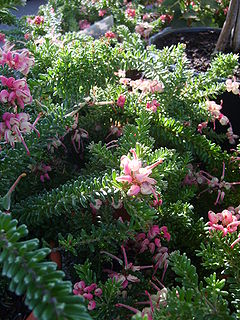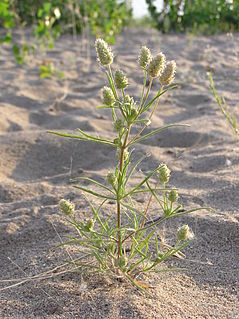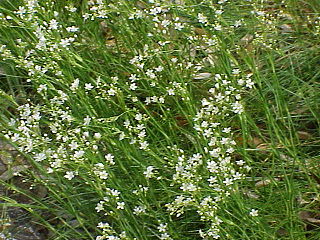
Ammophila is a genus of flowering plants consisting of two or three very similar species of grasses. The common names for these grasses include marram grass, bent grass, and beachgrass. These grasses are found almost exclusively on the first line of coastal sand dunes. Their extensive systems of creeping underground stems or rhizomes allow them to thrive under conditions of shifting sands and high winds, and to help stabilize and prevent coastal erosion. Ammophila species are native to the coasts of the North Atlantic Ocean where they are usually the dominant species on sand dunes. Their native range includes few inland regions, with the Great Lakes of North America being the main exception. The genus name Ammophila originates from the Greek words ἄμμος (ámmos), meaning "sand", and φίλος (philos), meaning "friend".
There are 164 vascular plant species on the Norwegian Arctic archipelago of Svalbard. This figure does not include algae, mosses, and lichens, which are non-vascular plants. For an island so far north, 164 species constitutes an astonishing variety of plant life. Because of the harsh climate and the short growing season, all the plants are slow growing. They seldom grow higher than 10 cm.
Arenaria, a Latin word meaning sand-loving, may refer to :

Arenaria is a genus of flowering plants, within the family Caryophyllaceae.

Arenaria balearica, the mossy sandwort, is a species of flowering plant in the family Caryophyllaceae, native to the Balearic Islands, Corsica, Sardinia and mainland Italy. It was first described by Carl Linnaeus in 1768.

Ammophila arenaria is a species of flowering plant in the grass family Poaceae. It is known by the common names marram grass and European beachgrass. It is one of two species of the genus Ammophila. It is native to the coastlines of Europe and North Africa where it grows in the sands of beach dunes. It is a perennial grass forming stiff, hardy clumps of erect stems up to 1.2 metres (3.9 ft) in height. It grows from a network of thick rhizomes which give it a sturdy anchor in its sand substrate and allow it to spread upward as sand accumulates. These rhizomes can grow laterally by 2 metres (7 feet) in six months. One clump can produce 100 new shoots annually.

Grevillea lanigera, commonly known as woolly grevillea, is a small shrub which is endemic to Victoria and New South Wales in Australia.

Varangerhalvøya National Park lies on the Varanger Peninsula in Finnmark county, Norway. It is located in the municipalities of Båtsfjord, Nesseby, Vadsø, and Vardø, in the northeasternmost part of Norway. The peninsula is the largest area within the Arctic climate zone in mainland Norway.
Arenaria nevadensis is a species of flowering plant in the family Caryophyllaceae. It is endemic to Spain. Its natural habitat is Mediterranean Matorral shrubby vegetation. It is threatened by habitat loss.

Grevillea arenaria is a shrub which is endemic to the east of New South Wales in Australia. It has an erect to spreading habit and grows to between 1 and 3 metres in height. Its leaves are 1.5 to 7 cm long and 3 to 15 mm in width. The flowers, which occur in groups of 2 to 10, are pink, red or orange, with green or yellow at the base and green styles. These occur year-round, with a major flourish in spring.
Grevillea kedumbensis is a shrub which is endemic to a restricted locale in the Great Dividing Range in central New South Wales in Australia.
Veronica arenaria is a flowering plant species in the family Plantaginaceae. It is native to New South Wales and Queensland Australia.

Iris arenaria is a species in the genus Iris; it is also in the subgenus of Iris and in the Psammiris section. It is a rhizomatous perennial, from Central Europe, found in Hungary, Austria, Romania, Czech Republic and Ukraine. It has grass-like leaves, a short stem and pale yellow flowers. It has had a mixed origin and was once Iris humilis subsp. arenaria, a subspecies of Iris humilis, until it was reclassified as a separate species. But many sources still state that it is either a synonym or subspecies of Iris humilis. It is cultivated as an ornamental plant in temperate regions.
Artemisia arenaria is a species of flowering plant in the family Asteraceae, native from Ukraine to Central Asia. It was first described by de Candolle in 1838.
Arenaria libanotica, commonly known as Lebanon sandwort, is a species of flowering plant in the family Caryophyllaceae. This species was first described by Kotschy in 1867.

Plantago indica, commonly known as branched plantain, sand plantain, or black psyllium, is a flowering plant in the plantain family Plantaginaceae, and is one of a few species in the Plantago genus under the common name psyllium. The plant is native to parts of Africa, Europe, Russia, and Asia, and has been naturalized in many other areas such as Australia and North America. The plant can be found mostly in dry inland areas, such as those that are sandy, and has also naturalized on roadsides and in meadows. The plant is not used broadly as a food source, but has been cultivated for its seeds which serve a medicinal use as a laxative.
Salvia arenaria is a perennial plant species of the family Lamiaceae. It is native to Brazil.
Arenaria humifusa is a species of flowering plant belonging to the family Caryophyllaceae.

Eremogone saxatilis is a species of flowering plant belonging to the family Caryophyllaceae.
Stenotis is a genus of flowering plants belonging to the family Rubiaceae.










